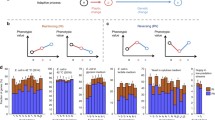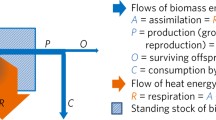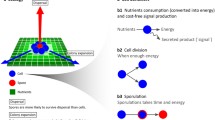Abstract
Understanding evolutionary trajectories remains a difficult task. This is because natural evolutionary processes are simultaneously affected by various types of constraints acting at the different levels of biological organization. Of particular importance are constraints where correlated changes occur in opposite directions, called trade-offs. Here we review and classify the main evolutionary constraints and trade-offs, operating at all levels of trait hierarchy. Special attention is given to life history trade-offs and the conflict between the survival and reproduction components of fitness. Cellular mechanisms underlying fitness trade-offs are described. At the metabolic level, a linear trade-off between growth and flux variability was found, employing bacterial genome-scale metabolic reconstructions. Its analysis indicates that flux variability can be considered as the currency of fitness. This currency is used for fitness transfer between fitness components during adaptations. Finally, a discussion is made regarding the constraints which limit the increase in the amount of fitness currency during evolution, suggesting that occupancy constraints are probably the main restrictions.



Similar content being viewed by others
References
Acerenza L (1993) Metabolic control design. J Theor Biol 165:63–85
Acerenza L (1996a) How constrained is metabolic control? J Theor Biol 182:277–283
Acerenza L (1996b) Sensitivity constraints in a chemical/biochemical highly responsive system. BioSystems 39:109–116
Acerenza L, Graña M (2006) On the origins of a crowded cytoplasm. J Mol Evol 63:583–590
Acerenza L, Cristina E, Hernández JA (2011) Regulatory design in a simple system integrating membrane potential generation and metabolic ATP consumption. Robustness and the role of energy dissipating processes. Biochim Biophys Acta 1807:1634–1646
Agrawal AA, Conner JK, Rasmann S (2010) Tradeoffs and negative correlations in evolutionary ecology. In: Bell MA, Eanes WF, Futuyma DJ, Levinton JS (eds) Evolution after Darwin: the first 150 years. Sinauer Associates, Sunderland, pp 243–268
Andersson DI (2014) Evolution of Antibiotic Resistance. In: Losos JB (ed) The Princeton guide to evolution. Princeton University Press, Princeton, pp 747–753
Antonovics J, van Tienderen PH (1991) Ontoecogenophyloconstraints? The chaos of constraint terminology. Trends Ecol Evol 6:166–168
Arnold SJ (1992) Constraints on phenotypic evolution. Am Nat 140:S85–S107
Arnold SJ, Pfrender ME, Jones AG (2001) The adaptive landscape as a conceptual bridge between micro and macroevolution. Genetica 112–113:9–32
Ashby WR (1956) An introduction to cybernetics. Chapman and Hall, London
Balaban NQ, Merrin J, Chait R, Kowalik L, Leibler S (2004) Bacterial persistence as a phenotypic switch. Science 305:1622–1625
Bar-Even A, Flamholz A, Noor E, Milo R (2012) Rethinking glycolysis: on the biochemical logic of metabolic pathways. Nat Chem Biol 8:509–517
Bennett AF, Lenski RE (2007) An experimental test of evolutionary trade-offs during temperature adaptation. P Natl Acad Sci USA 104:8649–8654
Bochdanovits Z, de Jong G (2004) Antagonistic pleiotropy for life-history traits at the gene expression level. P Roy Soc Lond B 271:S75–S78
Bolton MD (2009) Primary metabolism and plant defense—fuel for the fire. Mol Plant-Microbe Interact 22:487–497
Brakefield PM, Roskam JC (2006) Exploring evolutionary constraints is a task for an integrative evolutionary biology. Am Nat 168:S4–S13
Brand MD, Chien LF, Ainscow EK, Rolfe DFS, Porter RK (1994) The causes and functions of mitochondrial proton leak. Biochim Biophys Acta 1187:132–139
Brodie ED III (1992) Correlational selection for color pattern and antipredator behavior in the garter snake Thamnophis ordinoides. Evolution 46:1284–1298
Brunke S, Hube B (2014) Adaptive prediction as a strategy in microbial infections. PLoS Pathog 10:e1004356
Chang DE, Smalley DJ, Conway T (2002) Gene expression profiling of Escherichia coli growth transitions: an expanded stringent response model. Mol Microbiol 45:289–306
Cooper VS, Lenski RE (2000) The population genetics of ecological specialization in evolving Escherichia coli populations. Nature 407:736–739
Endler JA (1980) Natural selection of color patterns in Poecilia reticulata. Evolution 34:76–91
Endler JA (1983) Natural and sexual selection on color patterns in poeciliid fishes. Environ Biol Fish 9:173–190
Farhadifar R, Baer CF, Valfort AC, Andersen EC, Muller-Reichert T, Delattre M, Needleman DJ (2015) Scaling, selection and evolutionary dynamics of the mitotic spindle. Curr Biol 25:732–740
Fischer E, Sauer U (2005) Large-scale in vivo flux analysis shows rigidity and suboptimal performance of Bacillus subtilis metabolism. Nat Genet 37:636–640
Futuyma DJ (2005) Evolution. Sinauer Associates Inc., Sunderland
Futuyma DJ, Bennett AF (2009) The importance of experimental studies in evolutionary biology. In: Garland T Jr, Rose MR (eds) Experimental evolution. University of California Press, California
Gardener MR, Ashby WR (1970) Connectance of large dynamic (cybernetic) systems: critical values for stability. Nature 228:784
Goldbeter A (1996) Biochemical oscillations and cellular rhythms. Cambridge University Press, Cambridge
Graña M, Acerenza L (2001) A model combining cell physiology and population genetics to explain Escherichia coli laboratory evolution. BMC Evol Biol 1:12
Green JBA, Sharpe J (2015) Positional information and reaction-diffusion: two big ideas in developmental biology combine. Development 142:1203–1211
Guerreiro R, Besson AA, Bellenger J, Ragot K, Lizard G, Faivre B, Sorci G (2012) Correlational selection on pro- and anti-inflammatory effectors. Evolution 66:3615–3623
Guillaume F, Otto SP (2012) Gene functional trade-offs and the evolution of pleiotropy. Genetics 192:1389–1409
Handorf T, Ebenhoh O, Heinrich R (2005) Expanding metabolic networks: scopes of compounds, robustness and evolution. J Mol Evol 61:498–512
Haverkorn van Rijsewijk BRB, Nanchen A, Nallet S, Kleijn RJ, Sauer U (2011) Large-scale 13C-flux analysis reveals distinct transcriptional control of respiratory and fermentative metabolism in Escherichia coli. Mol Syst Biol 7:477
Heinrich R, Schuster S (1996) The Regulation of cellular systems. Chapman and Hall, New York
Hoffmann A (2014) Evolutionary limits and constraints. In: Losos JB (ed) The Princeton guide to evolution. Princeton University Press, Princeton, pp 247–252
Hofmeyr JH, Kacser H, van der Merwe KJ (1986) Metabolic control analysis of moiety-conserved cycles. Eur J Biochem 155:631–641
Holder N (1983) Developmental constraints and the evolution of vertebrate limb patterns. J Theor Biol 104:451–471
Hughes BS, Cullum AJ, Bennett AF (2007) Evolutionary adaptation to environmental acidity in experimental lineages of Escherichia coli. Evolution 61:1725–1734
Hummert S, Bohl K, Basanta D, Deutsch A, Werner S, Theißen G, Schroeter A, Schuster S (2014) Evolutionary game theory: cells as players. Mol BioSyst 10:3044–3065
Jin DJ, Cagliero C, Zhou YN (2012) Growth rate regulation in Escherichia coli. FEMS Microbiol Rev 36:269–287
Kacser H, Burns JA (1973) The control of flux. Symp Soc Exp Biol 27:65–104
Karn MN, Penrose LS (1951) Birth weight and gestation time in relation to maternal age, parity, and infant survival. Ann Eugen 16:147–164
Keightley PD, Kacser H (1987) Dominance, pleiotropy and metabolic structure. Genetics 117:319–329
King EG, Roff DA, Fairbairn DJ (2010) Tradeoff acquisition and allocation in Gryllus firmus: a test of the Y model. J Evol Biol 24:256–264
Kottler VA, Fadeev A, Weigel D, Dreyer C (2013) Pigment pattern formation in the guppy, Poecilia reticulata, involves the Kita and Csf1ra receptor tyrosine kinases. Genetics 194:631–646
Lande R (1976) Natural selection and random genetic drift in phenotypic evolution. Evolution 30:314–334
Lande R (1979) Quantitative genetic analysis of multivariate evolution, applied to brain:body size allometry. Evolution 33:402–416
Leiby N, Marx CJ (2014) Metabolic erosion primarily through mutation accumulation, and not tradeoffs, drives limited evolution of substrate specificity in Escherichia coli. PLoS Biol 12:e1001789
Lenski RE (1998) Bacterial evolution and the cost of antibiotic resistance. Int Microbiol 1:265–270
Lenski RE, Travisano M (1994) Dynamics of adaptation and diversification: a 10,000-generation experiment with bacterial populations. P Natl Acad Sci USA 9:6808–6814
López-Maury L, Marguerat S, Bähler J (2008) Tuning gene expression to changing environments: from rapid responses to evolutionary adaptation. Nat Rev Genet 9:583–593
Lutkenhaus J, Mukherjee A (1996) Cell division. In: Neidhart FC (ed) Escherichia coli and Salmonella: cellular and molecular biology, 2nd edn. ASM Press, Washington DC, pp 1615–1626
Maad J (2000) Phenotypic selection in hawkmoth-pollinated Platanthera bifolia: targets and fitness surfaces. Evolution 54:112–123
Mahadevan R, Schilling CH (2003) The effects of alternate optimal solutions in constraint-based genome-scale metabolic models. Metab Eng 5:264–276
Marcusson LL, Frimodt-Møller N, Hughes D (2009) Interplay in the selection of fluoroquinolone resistance and bacterial fitness. PLoS Pathog 5(8):e1000541
Matyssek R, Schnyder H, Oßwald W, Ernst D, Munch JC, Pretzsch H (eds) (2012) Growth and defence in plants, ecological studies 220. Springer, Berlin
May R (1972) Will a large complex system be stable? Nature 238:413–414
May R (1974) Stability and complexity in model ecosystems. Princeton University Press, Princeton
Maynard Smith J, Burian R, Kauffman S, Alberch P, Campbell J, Goodwin B, Lande R, Raup D, Wolpert L (1985) Developmental constraints and evolution. Q Rev Biol 60:265–287
Mitchell A, Pilpel Y (2011) A mathematical model for adaptive prediction of environmental changes by microorganisms. P Natl Acad Sci USA 108:7271–7276
Mitchell A, Romano GH, Groisman B, Yona A, Dekel E, Kupiec M, Dahan O, Pilpel Y (2009) Adaptive prediction of environmental changes by microorganisms. Nature 460:220–224
Novak M, Pfeiffer T, Lenski RE, Sauer U, Bonhoeffer S (2006) Experimental tests for an evolutionary trade-off between growth rate and yield in E. coli. Am Nat 168:242–251
Nyström T (2004) Growth versus maintenance: a trade-off dictated by RNA polymerase availability and sigma factor competition? Mol Microbiol 54:855–862
Orr HA (2009) Fitness and its role in evolutionary genetics. Nat Rev Genet 10:531–539
Orth JD, Conrad TM, Na J, Lerman JA, Nam H, Feist AM, Palsson BØ (2011) A comprehensive genome-scale reconstruction of Escherichia coli metabolism. Mol Syst Biol 7:535
Oster GF, Murray JD (1989) Pattern formation models and developmental constraints. J Exp Zool 251:186–202
Palsson BØ (2006) Systems biology. Properties of reconstructed networks. Cambridge University Press, New York
Pfeiffer T, Schuster S, Bonhoeffer S (2001) Cooperation and competition in the evolution of ATP-producing pathways. Science 292:504–507
Pilizota T, Shaevitz JW (2014) Origins of Escherichia coli growth rate and cell shape changes at high external osmolality. Biophys J 107:1962–1969
Raymond J, Segre D (2006) The effect of oxygen on biochemical networks and the evolution of complex life. Science 311:1764–1767
Reder C (1988) Metabolic control theory: a structural approach. J Theor Biol 135:175–201
Rolfe DFS, Brand MD (1997) The physiological significance of mitochondrial proton leak in animal cells and tissues. Bioscience Rep 17:9–16
San Román M, Cancela H, Acerenza L (2014) Source and regulation of flux variability in Escherichia coli. BMC Sys Biol 8:67
Schluter D, Nychka D (1994) Exploring fitness surfaces. Am Nat 143:597–616
Shoval O, Sheftel H, Shinar G, Hart Y, Ramote O, Mayo A, Dekel E, Kavanagh K, Alon U (2012) Evolutionary trade-offs, Pareto optimality, and the geometry of phenotype space. Science 336:1157–1160
Simpson GG (1953) The major features of evolution. Columbia University Press, New York
Sinervo B, Svensson E (1998) Mechanistic and selective causes of life history trade-offs and plasticity. Oikos 83:432–442
Tawfik DS (2014) Accuracy-rate tradeoffs: how do enzymes meet demands of selectivity and catalytic efficiency? Curr Opin Chem Biol 21:73–80
Todesco M, Balasubramanian S, Hu TT, Traw MB, Horton M et al (2010) Natural allelic variation underlying a major fitness trade-off in Arabidopsis thaliana. Nature 465:632–636
Ulusu NN (2015) Evolution of enzyme kinetic mechanisms. J Mol Evol 80:251–257
van Noordwijk AJ, de Jong G (1986) Acquisition and allocation of resources: their influence on variation in life history tactics. Am Nat 128:137–142
Waddington CH (1942) Canalization of development and the inheritance of acquired characters. Nature 150:563–565
Waddington CH (1957) The strategy of the genes. George Allen & Unwin, Crows Nest
Zera AJ, Harshman LG (2001) The physiology of life-history trade-offs in animals. Annu Rev Ecol Syst 32:95–126
Zhuang K, Vemuri GN, Mahadevan R (2011) Economics of membrane occupancy and respiro-fermentation. Mol Syst Biol 7:500
Acknowledgments
The author acknowledges support from Programa de Desarrollo de las Ciencias Básicas (PEDECIBA, Montevideo) and Agencia Nacional de Investigación e Innovación (ANII, Montevideo).
Author information
Authors and Affiliations
Corresponding author
Rights and permissions
About this article
Cite this article
Acerenza, L. Constraints, Trade-offs and the Currency of Fitness. J Mol Evol 82, 117–127 (2016). https://doi.org/10.1007/s00239-016-9730-3
Received:
Accepted:
Published:
Issue Date:
DOI: https://doi.org/10.1007/s00239-016-9730-3




